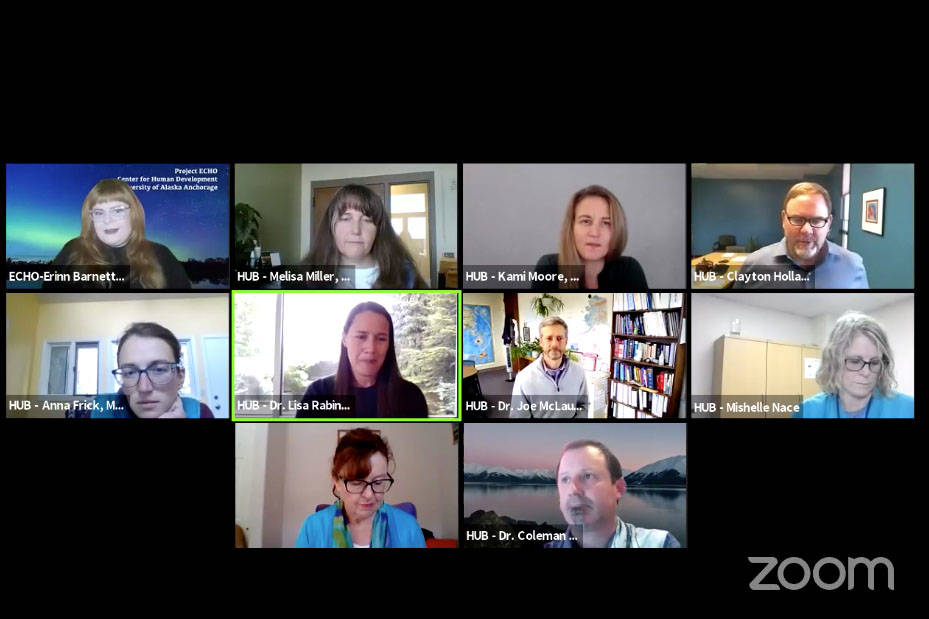Masking and vaccinations are the best way to keep children in schools, state health officials said at a virtual session with the Kenai Peninsula Borough School District last Thursday night.
The session, produced and facilitated by the University of Alaska Anchorage’s Alaska ECHO Project, was offered in partnership with the Alaska Department of Health and Social Services and the school district to allow KPBSD parents to ask questions of DHSS about the safe return of students to schools. It included a presentation on the COVID-19 situation on the Kenai Peninsula by Public Health Staff Physician Lisa Rabinowitz and input from other state health officials and KPBSD administrators.
The Kenai Peninsula Borough, like other regions in the state and across the country, is seeing a surge in COVID-19 cases fueled by the delta variant, Rabinowitz said, with about 97% of Alaska’s positive cases sequenced attributed to the variant. The biggest challenge posed by the delta variant is how contagious it is.
Alaska Chief Medical Officer Dr. Anne Zink said during a press conference the same night that, for comparison, if someone has influenza, they may spread it to one to two people. If someone has the original strain of COVID-19, they may spread the virus to two and a half people. If someone has the delta variant, they may spread it to between five and eight people. That, Zink said, is making it harder for public health workers to do their job.
Both the U.S. Centers for Disease Control and Prevention and the American Academy of Pediatrics recommend universal masking in schools as part of layered mitigation strategies, with the overarching goal of those agencies being to keep kids in school. What those strategies are, however, vary among Alaska school districts.
“The priority of all these school districts is the safety of their teachers, the students (and) the staff,” Rabinowitz said. “We all know that students benefit from in-person learning, and that’s kind of our focus this year, (is) to make it as safe as we can.”
The biggest thing to consider when looking at keeping schools open, Rabinowitz said, is the level of community COVID-19 transmission and that community’s vaccination rate.
Confidence in masks for COVID-19 mitigation comes from studies, said Anna Frick, an epidemiologist with DHSS. Those studies have ranged from surveying robots that cough on each other in a lab, to studying their use in large populations, to analyzing communities where masks are required versus those where masks are not required.
“Places that require masking and places that have high masking compliance have much less COVID transmission than places that don’t,” Frick said. “Then when we do math modeling studies where we sort of look at different parameters for how COVID spreads and ways we might prevent COVID from spreading … we see that masking is an effective tool and that higher compliance with masking does a great job of preventing COVID transmission.”
That prevention is seen in the way masks function to prevent someone who doesn’t know they are infected with COVID from spewing virus into the air and to block aerosols that contain virus from getting near the wearer’s nose and mouth.
Kenai Peninsula Borough Superintendent Clayton Holland said masks continue to be optional in schools because of how some communities responded to the requirement during the 2020-2021 school year, but that the district’s mitigation plan is adjustable. For example, in some communities students refused to attend because of the requirement. That means, Cutchins said, requiring masks doesn’t always achieve the goal of keeping kids in school.
“We’re going to keep adjusting to keep our kids safe and in school,” Holland said.
Many of the questions submitted ahead of the conference by parents were about masks and vaccines.
Cutchins said that people on the Kenai Peninsula would not have to worry about masking if the borough’s vaccination rate was higher. As of Friday, about 46.3% of Alaskans 12 and older in the borough were fully vaccinated and about 50.1% were partially vaccinated.
“From the medical side of it, yes, we have great data on masks,” Cutchins said. “They’re our second-best prevention tool behind vaccine — vaccine is by far our best prevention tool. If (the) Kenai Peninsula was 90%, 95%, 100% vaccinated, you wouldn’t have to worry about masks, you know? I mean, if you really want to do away with masks, vaccine is the way to do that.”
In considering school safety, Rabinowitz said vaccines and mitigation go a long way to protect children under 12, who are not yet eligible to be vaccinated.
“We have this group of kids 12 and under that can’t get vaccinated yet and they’re interacting with other members of the community,” Rabinowitz said. “As many of the eligible individuals … get vaccinated, you’re just adding extra layers of protection to your community and school.”
Vaccination status and masks also have a big impact on whether or not students who have been exposed to someone with COVID-19 can return to school. A close contact who is vaccinated can go to school while masked, for example, but a close contact who is not vaccinated must quarantine at home unless they’ve tested positive for COVID within the last 90 days.
KPBSD’s full COVID-19 mitigation plan, as well as community case numbers and quarantine protocols for vaccinated and unvaccinated students, is available on the district’s COVID-19 website at covid19.kpbsd.org.
Thursday’s full ECHO with the school district can be viewed on the Facebook pages of both KPBSD and DHSS.
Reach reporter Ashlyn O’Hara at ashlyn.ohara@peninsulaclarion.com.


